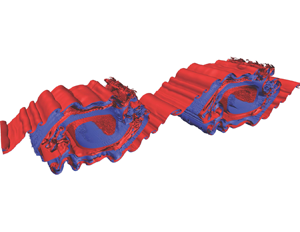Article contents
Goldilocks mixing in oceanic shear-induced turbulent overturns
Published online by Cambridge University Press: 04 October 2021
Abstract

We present a new, simple and physically motivated parameterization, based on the ratio of Thorpe and Ozmidov scales, for the irreversible turbulent flux coefficient  $\varGamma _{\mathcal {M}}= {\mathcal {M}}/\epsilon$, i.e. the ratio of the irreversible rate
$\varGamma _{\mathcal {M}}= {\mathcal {M}}/\epsilon$, i.e. the ratio of the irreversible rate  ${\mathcal {M}}$ at which the background potential energy increases in a stratified flow due to macroscopic motions to the dissipation rate of turbulent kinetic energy
${\mathcal {M}}$ at which the background potential energy increases in a stratified flow due to macroscopic motions to the dissipation rate of turbulent kinetic energy  $\epsilon$. Our parameterization covers all three key phases (crucially, in time) of a shear-induced stratified turbulence life cycle: the initial, ‘hot’ growing phase, the intermediate energetically forced phase and the final ‘cold’ fossilization decaying phase. Covering all three phases allows us to highlight the importance of the intermediate one, to which we refer as the ‘Goldilocks’ phase due to its apparently optimal (and so neither too hot nor too cold, but just right) balance, in which energy transfer from background shear to the turbulent mixing is most efficient. The value of
$\epsilon$. Our parameterization covers all three key phases (crucially, in time) of a shear-induced stratified turbulence life cycle: the initial, ‘hot’ growing phase, the intermediate energetically forced phase and the final ‘cold’ fossilization decaying phase. Covering all three phases allows us to highlight the importance of the intermediate one, to which we refer as the ‘Goldilocks’ phase due to its apparently optimal (and so neither too hot nor too cold, but just right) balance, in which energy transfer from background shear to the turbulent mixing is most efficient. The value of  $\varGamma _{\mathcal {M}}$ is close to 1/3 during this phase, which we demonstrate appears to be related to an adjustment towards a critical or marginal Richardson number for sustained turbulence
$\varGamma _{\mathcal {M}}$ is close to 1/3 during this phase, which we demonstrate appears to be related to an adjustment towards a critical or marginal Richardson number for sustained turbulence  ${\sim }0.2\text {--}0.25$. Importantly, although buoyancy effects are still significant at leading order for the turbulent dynamics during this intermediate phase, the marginal balance in the flow ensures that the turbulent mixing of the (density) scalar is nevertheless effectively ‘locked’ to the turbulent mixing of momentum. We present supporting evidence for our parameterization through comparison with six oceanographic datasets that span various turbulence generation regimes and a wide range of geographical location and depth. Using these observations, we highlight the significance of parameterizing an inherently variable flux coefficient for capturing the turbulent flux associated with rare energetic, yet fundamentally shear-driven (and so not strongly stratified) overturns that make a disproportionate contribution to the total mixing. We also highlight the importance of representation of young turbulent patches in the parameterization for connecting the small scale physics to larger scale applications of mixing such as ocean circulation and tracer budgets. Shear-induced turbulence is therefore central to irreversible mixing in the world's oceans, apparently even close to the seafloor, and it is critically important to appreciate the inherent time dependence and evolution of mixing events: history matters to mixing.
${\sim }0.2\text {--}0.25$. Importantly, although buoyancy effects are still significant at leading order for the turbulent dynamics during this intermediate phase, the marginal balance in the flow ensures that the turbulent mixing of the (density) scalar is nevertheless effectively ‘locked’ to the turbulent mixing of momentum. We present supporting evidence for our parameterization through comparison with six oceanographic datasets that span various turbulence generation regimes and a wide range of geographical location and depth. Using these observations, we highlight the significance of parameterizing an inherently variable flux coefficient for capturing the turbulent flux associated with rare energetic, yet fundamentally shear-driven (and so not strongly stratified) overturns that make a disproportionate contribution to the total mixing. We also highlight the importance of representation of young turbulent patches in the parameterization for connecting the small scale physics to larger scale applications of mixing such as ocean circulation and tracer budgets. Shear-induced turbulence is therefore central to irreversible mixing in the world's oceans, apparently even close to the seafloor, and it is critically important to appreciate the inherent time dependence and evolution of mixing events: history matters to mixing.
- Type
- JFM Papers
- Information
- Copyright
- © The Author(s), 2021. Published by Cambridge University Press
References
REFERENCES
- 28
- Cited by



